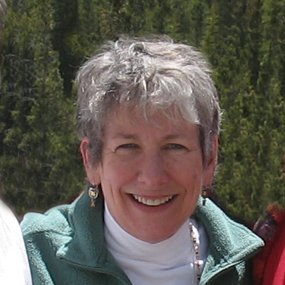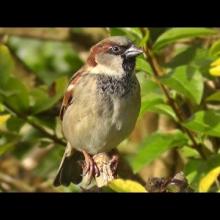

Join BirdNote tomorrow, November 30th!
Illustrator David Sibley and actor H. Jon Benjamin will face off in the bird illustration battle of the century during BirdNote's Year-end Celebration and Auction!
The House Sparrow was first introduced into the US from England in the 1850s and has spread across the country. The name "House Sparrow" fits it well, because – from Bangor, Maine to San Diego, and Alaska to the Panama Canal – it's found nearly everywhere people live.
BirdNote®
House Sparrow – An Introduction
Written by Ellen Blackstone
This is BirdNote.
[Chirping of a House Sparrow]
Thanks to a well-meaning – but misguided – soul, the House Sparrow was first introduced into the U.S. from England in the 1850s. And it’s now one of the most common birds in North America. The name “House Sparrow” fits it well, because – from Bangor, Maine to San Diego, British Columbia to the Panama Canal – and even in Hawaii – it’s found nearly everywhere people live. [Rising chatter of many sparrows in an urban setting]
A stocky little street-fighter of a bird, it’s fussy and vocal year ‘round. Sparrows often seem to be scrapping with each other, but still, they’re always in a group, almost never alone. Sometimes a bush they’ve settled in seems to be alive with their chatter, even though you can’t see a single bird. [Fussy chatter of many sparrows]
They even like to bathe together. True to their name, they prefer to nest in manmade structures or birdhouses, rather than in trees. And given a chance, they displace many of our native cavity-nesting birds from nest boxes. Emily Dickinson described the sparrow’s nest as “Sweet of twigs and twine.” There’s a lot of both in a nest, because when sparrows find a cavity they like, they’ll fill up every bit of space before laying their eggs.[Chirping of a House Sparrow]
Peer into a sparrow’s nest, on our website, BirdNote.org. I’m Michael Stein.
###
Call of the House Sparrow provided by The Macaulay Library of Natural Sounds at the Cornell Lab of Ornithology, Ithaca, New York. Individual recorded by G.A. Keller. Flock recorded by W.W.H. Gunn.
Ambient recorded by Kessler Productions.
BirdNote's theme music was composed and played by Nancy Rumbel and produced by John Kessler.
Producer: John Kessler
Executive Producer: Chris Peterson / Dominic Black
© 2015 Tune In to Nature.org April 2017 / 2020 Narrator: Michael Stein
ID# 040606HOSPKPLU HOSP-02b







